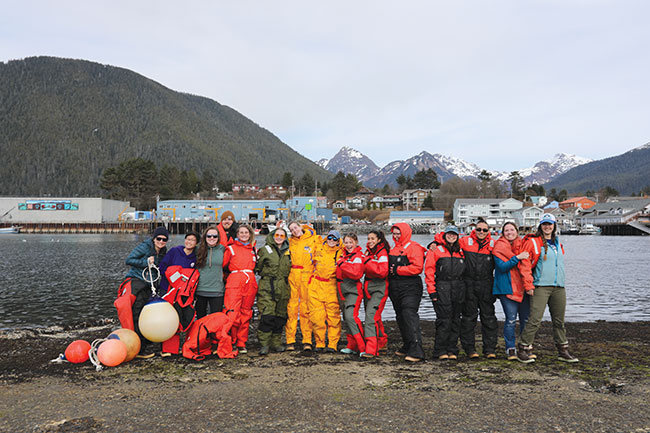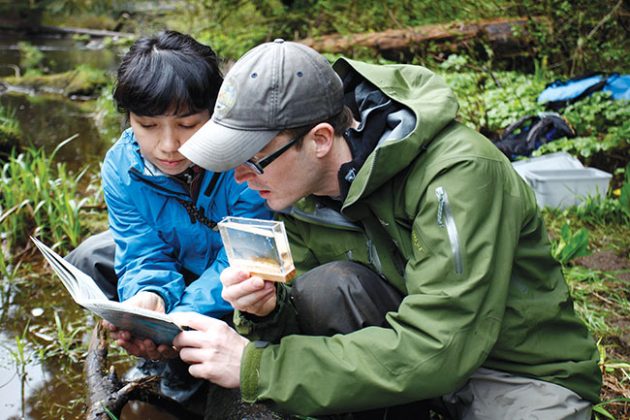
Helping Alaska’s mariculture development move forward
May 20, 2020
By
Liza Mayer
Brought to you by University of Alaska Southeast
 Students at the University of Alaska Southeast receive training for a rewarding career in fisheries
Students at the University of Alaska Southeast receive training for a rewarding career in fisheries The University of Alaska Southeast (UAS) in Sitka is helping develop the required manpower for Alaska’s growing aquaculture industry.
The enthusiasm for mariculture development in Alaska that’s been brewing in recent years reached a new high early this year with the state getting—for the first time— its own aquaculture coordinator from the National Oceanic and Atmospheric Administration. Industry stakeholders in Alaska believe this move will help advance the state’s mariculture development.
“Alaska is currently experiencing a shortage of fisheries technicians and fisheries biologists, a trend predicted to continue into the future. Our classes allow students to study wherever they are—whether in their home or out on a vessel—without disrupting their routines. These studies can lead to careers in aquaculture or fisheries management,” said the University.
The Sitka Campus of UAS has partnered with industry and regulatory agencies to develop programs that can meet the state’s growing need for qualified personnel.
Students can learn in various ways: from classes on university-provided iPads that are pre-loaded (and therefore don’t need Internet connection) with lectures, exams and readings to hands-on classes in Diving and Aquaculture.
Learning on the go
Most Fisheries Technology courses can be taken online, at the student’s own pace, either in an online “hybrid” format with the student tuning in locally or from anywhere there is an Internet connection, or on the pre-loaded iPads. The iPads are loaned to the student by UAS. They contain all lectures, videos, readings, FAQs, and even the exams, which can be taken remotely without proctoring services. “These ‘off-the-grid’ courses allow the student to complete an entire course at his or her own pace,” said the University.
The iPad course offerings include:
- Introduction to Fisheries of Alaska, Alaska Salmon Culture I
- Alaska Salmon Culture II
- Oceanography
- Fish Biology
- Fisheries Management
- Law and Economics
- Fisheries Management Techniques
To see a list of upcoming courses visit: http://www.uas.alaska.edu/career_ed/fisheries/classes.html
UAS programs include the Fisheries Technology Occupational Endorsements, Certificates and the Associate of Applied Science (A.A.S.) in Fisheries Management and/or Aquaculture. Completion of the programs can lead to employment opportunities in a wide range of potential careers, including fish technicians or culturists, fisheries management assistants, fisheries observers, fish research technicians, fish and wildlife surveyors, habitat restoration technicians, natural resource technicians, stream surveyors, weir technicians or commercial fishers. UAS Fisheries Technology faculty and staff are available to discuss job availability, career paths, or educational next steps. They can be reached at (907) 747-7777 or 1(800)-478-6653.

Most Fisheries Technology courses can be taken online, at the student’s own pace
Hands-on, intensive learning
UAS also offers Semester Intensives for hands-on learning in both diving and aquaculture.
As part of the Dive Semester, students will have the opportunity to work with UAS faculty and become accomplished research divers. They will learn everything from basic dive skills to underwater rescue procedures and underwater data collection techniques. They will become familiar with local fish and invertebrate species while participating in new and ongoing marine-related research projects, as well as develop skills critical to underwater fieldwork such as basic skiff handling and small engine maintenance techniques.
The program offers students the opportunity to earn certifications as open water divers, dry suit divers, advanced open water divers, research divers, AAUS scientific divers, and DAN 1st Aid/ CPR and O2 providers, along with gaining experience in cold-water research and fieldwork.
Visit http://divesemester.alaska.edu/ for more information.
A field-based program called The Alaska Aquaculture Semester is available for students interested in aquaculture.
Sitka has developed a reputation as a stronghold for salmon aquaculture within the state and has many opportunities for mariculture development as well. There are three Pacific Salmon hatcheries in the region: the Sheldon Jackson Hatchery, which works in partnership with the Sitka Sound Science Center; the Northern Southeast Regional Aquaculture Association of Sitka, which runs Medvejie Hatchery; and the Sawmill Creek Hatchery.
Students in the Alaska Aquaculture Semester will have the opportunity to work with UAS faculty and with local industry partners to learn in the classroom and in the field about aquaculture. Part of the course work are the ins and outs of Alaskan salmon culture and the associated fisheries, seaweed and shellfish mariculture, skiff handling, small engine maintenance techniques, cold-water survival and everything in between. Students will visit remote sites via floatplane or boat and get to experience a side of Alaskan fisheries few people get to see. Contact Angie Bowers at (907) 747-7742 or abowers4@alaska.edu for more information.
For registration or any question, call (907) 747-7777 or 1(800)-478-6653.
Advertisement
- B.C. salmon farmers adapt to new reality
- Whole Oceans appoints project coordinator for planned Maine RAS farm





